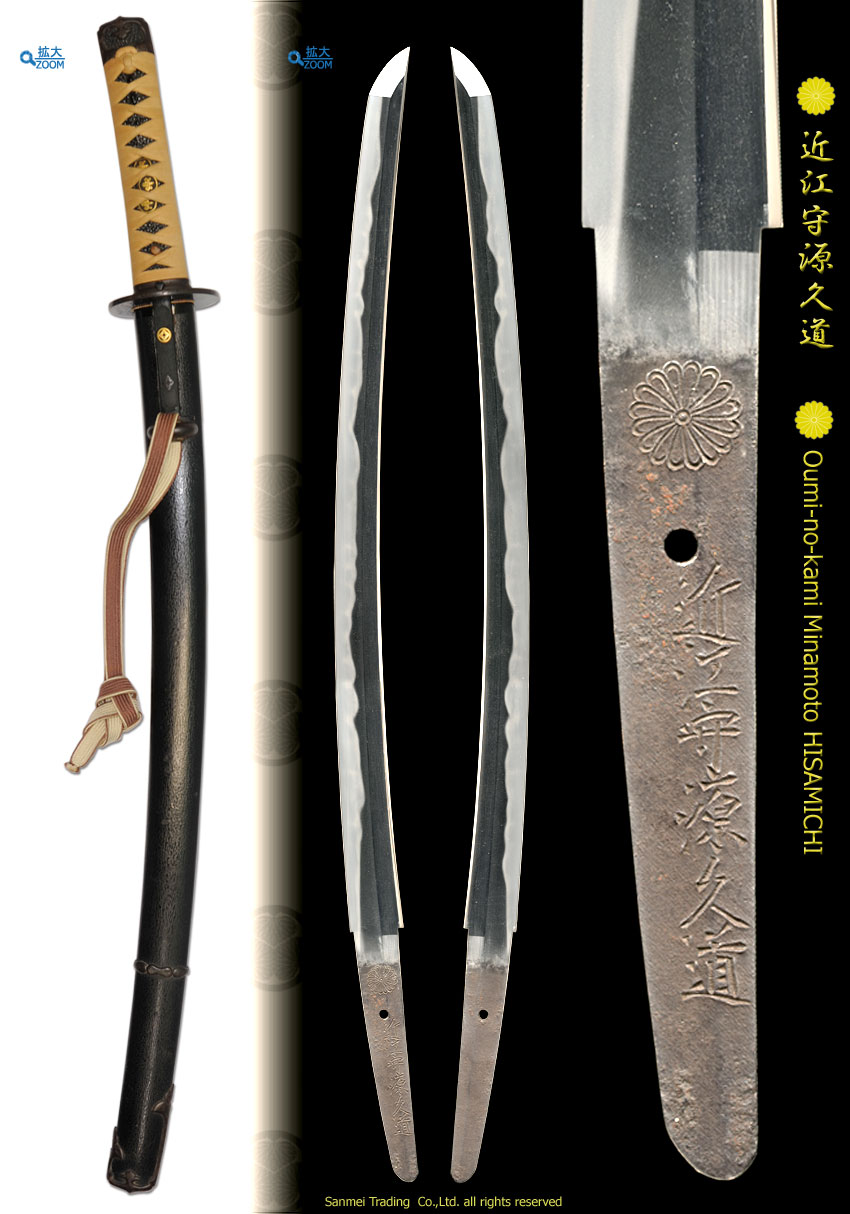with) Black wrinkles leather skin finishing surface scabbard Han-tachi style wakizashi Koshirae
Length of cutting edge 55.4cm Curvature 1.7cm Width of base 33.3mm Width of Yokote 22.4mm Thickness of base 7.2mm
Kitae(forging pattern) : Kitae-hada is fine Itame-hada (wooden grain) generally mixing in with some indication of burl mark so called Mokume-hada in which Hiraji surface is covered with abundant sparkling ji-nie that generates darkish Nie lines so called CHIKEI activity.The entire steel forging is fully bright like an obi interwoven with gold thread.
Hamon(tempering pattern) : Thick Nie sparkling glitter lays deeply along the temper edge. Hamon starts with straight Suguha to form Yakidashi then wide wavy Notare, mixture of large gunome or large clove outlines and some temper splash spilled into surface so called Yubashiri. Some of Yakiba almost reaches to the shinogi-ji ridge, vividly clear and dynamic Hamon and interior of temper activates with bright Kinsuji or Sunagashi work.There is frequent thick nie feet glows toward the hardened edge. The interior of temper is filled in rich crystalized Nioi-mist, vividly bright, gaily decorated.
Boshi (tip): The temper of tip becomes straight indication below Yokote, medium circle with Hakikake blushing up indication turns back.
Nakago(tang) : Original UBU with one mekugi-ana retaining hole. O-sujikai (slanting leftward) file marks. Iriyama (V-shape) heel. The signature in front starts with 16 petals chrysanthemum flower KIKU-mon 菊紋, the an official district title Omi-no-kami 近江守, clan name Minamoto 源 then smith name HISAMICHI 久道.
The first smith HISAMICHI, real name HORI ROKUROUBEI 掘六郎兵衛 is a pupil of 2nd gen. Iga-no-kami KINMICHI 伊賀守金道 to establish one of the five major schools so called "KYO-GOKAJI" in Kyoto - Iganokami KINMICHI 伊賀守金道, Izuminokami KINMICHI 和泉守金道, Tanbanokami YOSHIMICHI 丹波守吉道, Echunokami MASATOSHI 越中守正俊 and himself - Ouminokami HISAMICHI 近江守久道.
He enjoyed Oumi-daijo title in the 1st year of kanbun (1661) and also Oumi-no-kami title in the same year. Many of his own works are chiselled with "16 petals KIKU-mon" and it is understood that ones with "Twig KIKU-mon" on after 8th year of Enpo (1680) are DAISAKU, made by 2nd gen. This is a typical example of HISAMICHI work made by 1st gen., on after he enjoyed Oumi-no-kami title in 1661. He studied from Igano-kami KINMICHI and MISHINA school influence can be seen in the Jihada Kitae and Boshi. In view of heroic shape, careful forging and fine steel, it is guessed that this sword was made to order by strong and sturdy Samurai. Fresh polish and flawless almost mint condition.
Another highlight is an old original Koshirae.
Black wrinkles leather skin finishing surface scabbard Han-tachi style wakizashi Koshirae consists of:
Black lacquered rayskin fumigate leather lozenge cord wrap hilt.
Black patina finish full set of Fuchi/Kashira, Kurikata, Semekanagu and Kojiri.
KIRI crest SANSO triple style Menuki, Shakudo ground Yobori, Gold iroe.
Tsuba dragon, Shibuichi copper aooly polish ground, Katagiri carving.
Kozuka/Kogai Futatokoromono, family crests motif Shakudo ground Nanakoji surface Takabori Gold Iroe inlay
(click HERE for each ornamental fitting in detail/click HERE for the entire koshirae fitting)
Preserved in a shira-saya plain wood mounting. Gold foiled single habak collar.
Recent polish/Condition scale: mint-excellent (using a scale of mint-excellent-very good-good-fair-poor).

